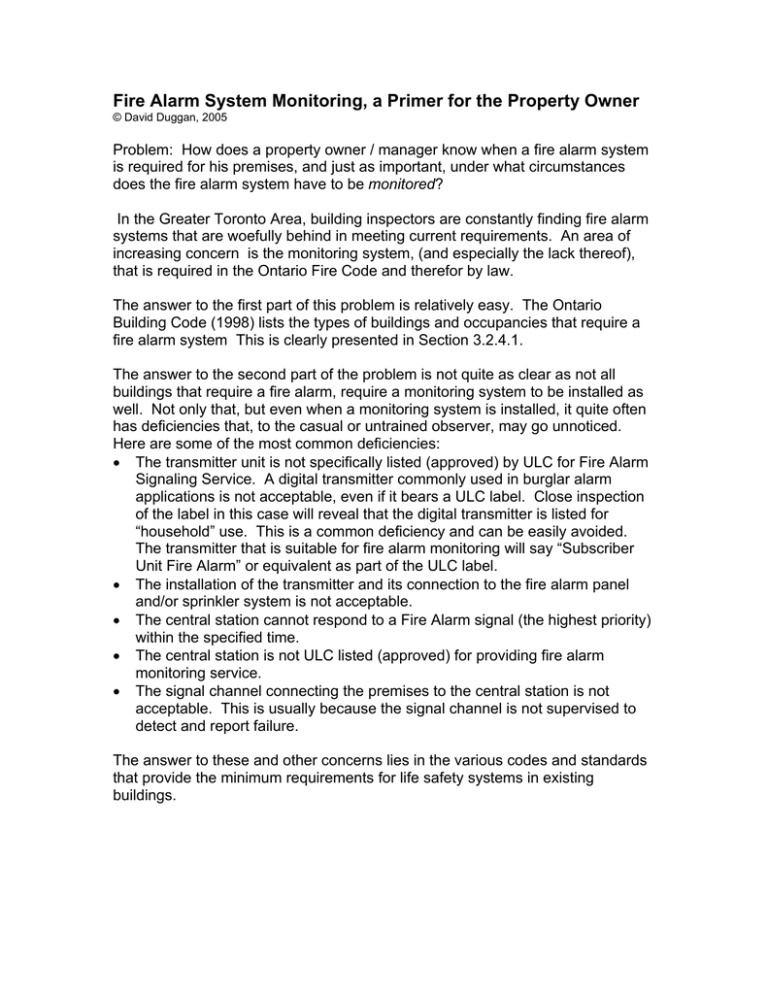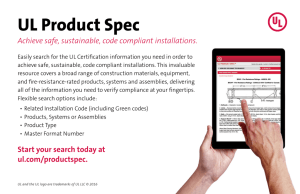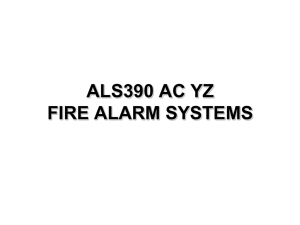Fire Alarm System Monitoring, a Primer for the Property Owner
advertisement

Fire Alarm System Monitoring, a Primer for the Property Owner © David Duggan, 2005 Problem: How does a property owner / manager know when a fire alarm system is required for his premises, and just as important, under what circumstances does the fire alarm system have to be monitored? In the Greater Toronto Area, building inspectors are constantly finding fire alarm systems that are woefully behind in meeting current requirements. An area of increasing concern is the monitoring system, (and especially the lack thereof), that is required in the Ontario Fire Code and therefor by law. The answer to the first part of this problem is relatively easy. The Ontario Building Code (1998) lists the types of buildings and occupancies that require a fire alarm system This is clearly presented in Section 3.2.4.1. The answer to the second part of the problem is not quite as clear as not all buildings that require a fire alarm, require a monitoring system to be installed as well. Not only that, but even when a monitoring system is installed, it quite often has deficiencies that, to the casual or untrained observer, may go unnoticed. Here are some of the most common deficiencies: • The transmitter unit is not specifically listed (approved) by ULC for Fire Alarm Signaling Service. A digital transmitter commonly used in burglar alarm applications is not acceptable, even if it bears a ULC label. Close inspection of the label in this case will reveal that the digital transmitter is listed for “household” use. This is a common deficiency and can be easily avoided. The transmitter that is suitable for fire alarm monitoring will say “Subscriber Unit Fire Alarm” or equivalent as part of the ULC label. • The installation of the transmitter and its connection to the fire alarm panel and/or sprinkler system is not acceptable. • The central station cannot respond to a Fire Alarm signal (the highest priority) within the specified time. • The central station is not ULC listed (approved) for providing fire alarm monitoring service. • The signal channel connecting the premises to the central station is not acceptable. This is usually because the signal channel is not supervised to detect and report failure. The answer to these and other concerns lies in the various codes and standards that provide the minimum requirements for life safety systems in existing buildings. Fire Alarm Monitoring Requirements. Where are fire alarm monitoring systems required, according to the (current) 1997 Ontario Fire Code (OFC)? NOTE: The Ontario Fire Code regulates existing buildings. However Section 9, the Retrofit section, stipulates where fire alarm monitoring is required in buildings even if they were built before February, 1987, the OBC immediately preceding the current edition. 1) High Rise buildings, Section 9.6 (Retrofit) • Group C (Residential) Buildings higher than 6 storeys • With at least 2 dwelling units in these 6 storeys • Or more than 10 people boarding, lodging or rooming in these 6 storeys. • Section 9.6.4.6 refers to Group C buildings 18 meters in height, which corresponds to 6 storeys, and states requirement for “Signals to the Fire Department”. In brief…. If a Group C Residential building is 6 storeys or 18 meters (grade to floor of top storey) the fire alarm system must be monitored. 2) Health Care facilities, Section 9.4 (Retrofit) • Group B Occupancy in the OFC includes Homes for Special Care, Homes for the Aged & Rest Homes, Nursing Homes, Private Hospitals, and Public Hospitals. • Section 9.4.4.3 is where we find the requirements for “Signals to the Fire Department.” 3) Assembly Occupancies, Section 9.2 (Retrofit) • Almost all of these occupancies, except fixed seating in excess of 300, do not require monitoring. • Exceptions are building regulated by Education Act and Colleges and Universities Act. These buildings are monitored. Where are fire alarm monitoring systems required according to the (current) Ontario Building Code, 1998? NOTE: The OBC regulates new construction, renovation etc. as opposed to the Fire Code that takes over after construction is complete, and upon the granting of an occupancy permit for a building. The current Building Code (1998) dictates fire alarm monitoring requirements in new buildings as follows: • • • • • Group A (Assembly) if there will be fixed seating for more than 300 people., also referred to as the Occupant Load. Any Group B occupancy ( prisons, care facilities) Any Group F1 (Industrial, High Hazard) Any “High Building” defined in section 3.2.6 Buildings with interconnected floor spaces such as atriums and areas containing open stairways and escalators. How will the system be monitored? The Fire Code, which is the governing document for existing buildings, simply quotes the Building Code rather than repeat the requirements verbatim. Basically the Fire Code says in Section 9.6.4.6, the section dealing with residential occupancies, “The Fire Alarm Systems……shall have provision for notifying the Fire Department in accordance with sentences 3.2.4.7 (1) to 3.2.4.7 (4) of the 1990 Building Code So what does Section 3.2.4.7 (1) etc. of the Building Code say? It says that signals to the fire department shall be sent by way of a central station, one that conforms to a document called ULC/ORD-C693-1994. This document is the one that gets to the heart of the matter. It says that: • Fire alarm transmitting equipment, commonly referred to as the transmitter, shall be designed and built to the same ULC standard that applies to Fire Alarm Panels, Standard S527. • The transmitter and related devices shall be installed in the same manner as a fire alarm panel, in accordance with ULC standard S 524, the Installation Standard. • The transmitter shall be ULC listed, and bear a ULC label confirming that it is a unit suitable for transmitting Fire alarm, Supervisory, and System Trouble signals. The phrase “Subscriber Unit Fire Alarm” will appear on the ULC label, which of course must be affixed to the transmitter unit. If the word “household” or something similar appears on the label, the transmitter is not acceptable. • The communication channel connecting the transmitter to the central station must be supervised to detect and report any failure to the central station. • Alarm signals must be received and displayed at the central station within 1 minute of the fire alarm being activated at the premises. • The central station itself must be listed by ULC as being suitable for the reception of fire alarm and related signals. This means that the equipment in the station is ULC listed, records are maintained properly, staff are well trained and so on. • The company that installs the alarm transmitter, arranges for the installation of the signal channel and provides regular service to the transmitter must be ULC listed. Quite often this company is a fire alarm service company and not the central station company. In this case, the service company would be listed under the ULC “Shared Service Fire Protective Signaling System” certificate program, and will be able to provide their ULC proof-of-listing file number upon request. The quick and simple solution to the problem of understanding the type of equipment and service that is being offered to the property owner / manager, comes down to this. All the owner / manager has to ask for is: “ a fire alarm monitoring system that meets the current ULC requirements, and that a ULC Fire Protective Signaling Service Certificate for the monitoring system be provided.” Either a Full Service Certificate (central station company installs, monitors and services the monitoring system) or a Shared Service Certificate ( fire alarm service company installs and services system, a central station company provides monitoring) , is acceptable to the Fire Department. NOTE: In January, 2005, ULC created a new standard which supercedes the ORD-C693 document This standard has many improvements relating to the central station (which it now refers to as the Signal Receiving Centre) as well as the installation practices and functionality of the transmitting and receiving equipment. It provides a clearly understood set of requirements for the monitoring of fire alarm systems. When the next National Building Code is released, with a new Ontario Building Code following shortly thereafter, the new OBC will reference the new ULC Standard, S561. What can the owner / property manager expect from this certified monitoring service? • Of course, 24/7 monitoring of the building’s fire alarm system • Immediate dispatch (within 30 seconds) of the Fire Department if a fire alarm signal is generated. Unlike a burglar alarm signal, there can be no “verification” of the fire alarm signal. That is to say the central station operator cannot contact the premises to verify that the fire alarm signal is genuine. • Periodic inspection (approximately every two months) of the monitoring system for a Sprinkler system, and once per year for Fire Panel monitoring per Section 9.6 of CAN/ULC-S561-03. • Annual ULC inspections with the listed installing/monitoring companies to ensure ongoing compliance with ULC standards. • Maximum of 4 hour response by the service / monitoring company to any failure of the monitoring system, including the signal channel. • Notification of the premises (within 30 minutes) of any signal that requires owner attention such as a Supervisory condition relating to the sprinkler system i.e. low pressure warning or valve tampering. • Immediate notification of the Service Company of any Trouble or Supervisory signal, 24/7 basis. • A ULC Certificate advising that the monitoring system satisfies all code and standard requirements.. This certificate should be displayed in close proximity to the fire alarm panel. • A sticker containing the System Number, the name of the monitoring company, and the monitoring company’s phone number along with the name of the company providing the monitoring service will be affixed to a prominent surface in close proximity to the fire alarm panel. A personal I.D. number will be assigned to the building representative by the monitoring company. Any request to have the system put on test, i.e. suspended from monitoring, must be accompanied by this I.D. number. What should the monitoring service cost and should the customer expect to be under contract? There are some fixed costs associated with fire alarm monitoring. The signal channel, usually a facility that is provided by the telephone company, is in fact a supervised network that is separate form the ordinary telephone service. It requires the installation of a telephone company modem, and the lease of a circuit that makes up part of the network. The circuit which connects the building to the network is called a “leg” The company that is providing the monitoring service is responsible for the ordering of the modem and also for the network cost as well as the cost of the individual leg which connects the building to the network. In our case, here in the GTA, it is Bell Canada that charges these fees to the monitoring company. The monitoring company in turn passes on these signal channel fees to the customer as part of the overall monitoring fee. Also calculated into the monitoring cost is the labour to supply inspection and repair service on a 24/7 basis. Initially there is usually a one time installation fee for the transmitter and related equipment. After that, the customer may be given a choice of monthly billing for the monitoring service, however quarterly billing is the norm. Depending on the complexity of the monitoring system’s connection to the fire panel and/or sprinkler, an installation cost of the transmitter and related equipment of up to $500.00 could be expected. The ongoing monthly fee could range from $80.00 to $120.00 depending on various circumstances, with the monitoring of a single fire alarm panel at the lower end of the scale. It is common practice for the monitoring company to maintain ownership of the transmitter. This is because it is connected to their network, and it behooves them therefor to ensure that the transmitter is functioning perfectly at all times and will therefor not interfere with the proper operation of the network. As service to the transmitter could be required at any time, the building representative should be prepared to provide 24/7 access to the transmitter for the service / monitoring company personnel. A requirement of the ULC Certificate is that the building owner be under contractual obligation for monitoring service. Contract terms for this service may vary from 2 to 5 years, with a three year term being the most common. The contract may include provision for rate increases based on increases handed down by Bell Canada. It might also contain an evergreen clause allowing the contract to be automatically renewed after the initial term has expired. This assures that a contractual lapse that may go unnoticed by either party will be prevented.

